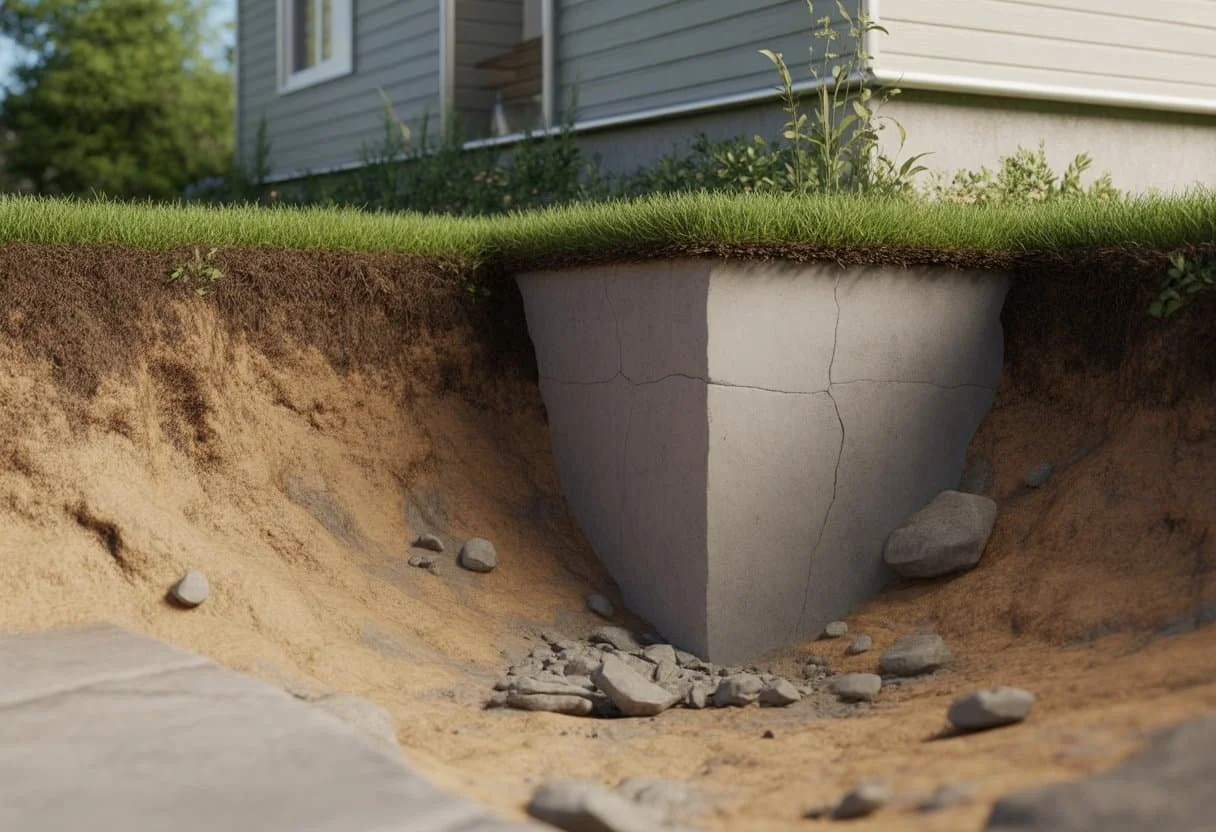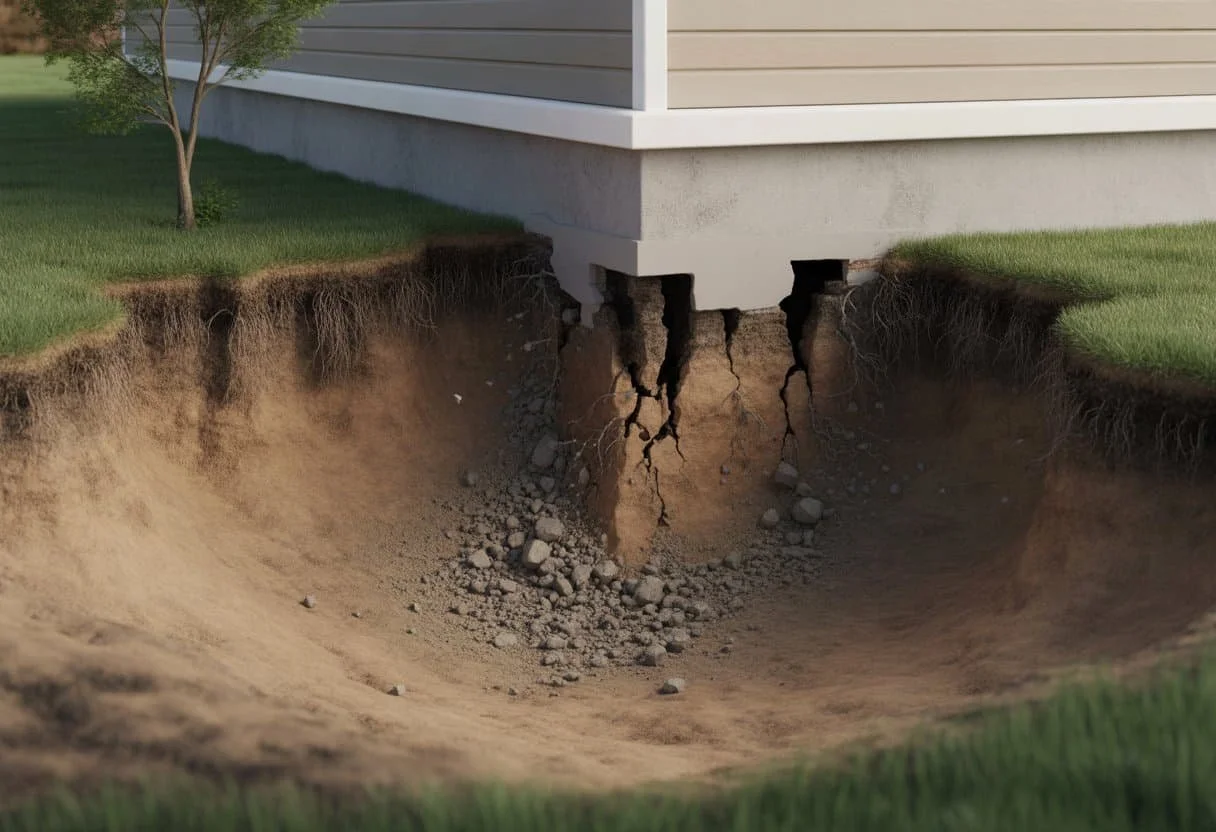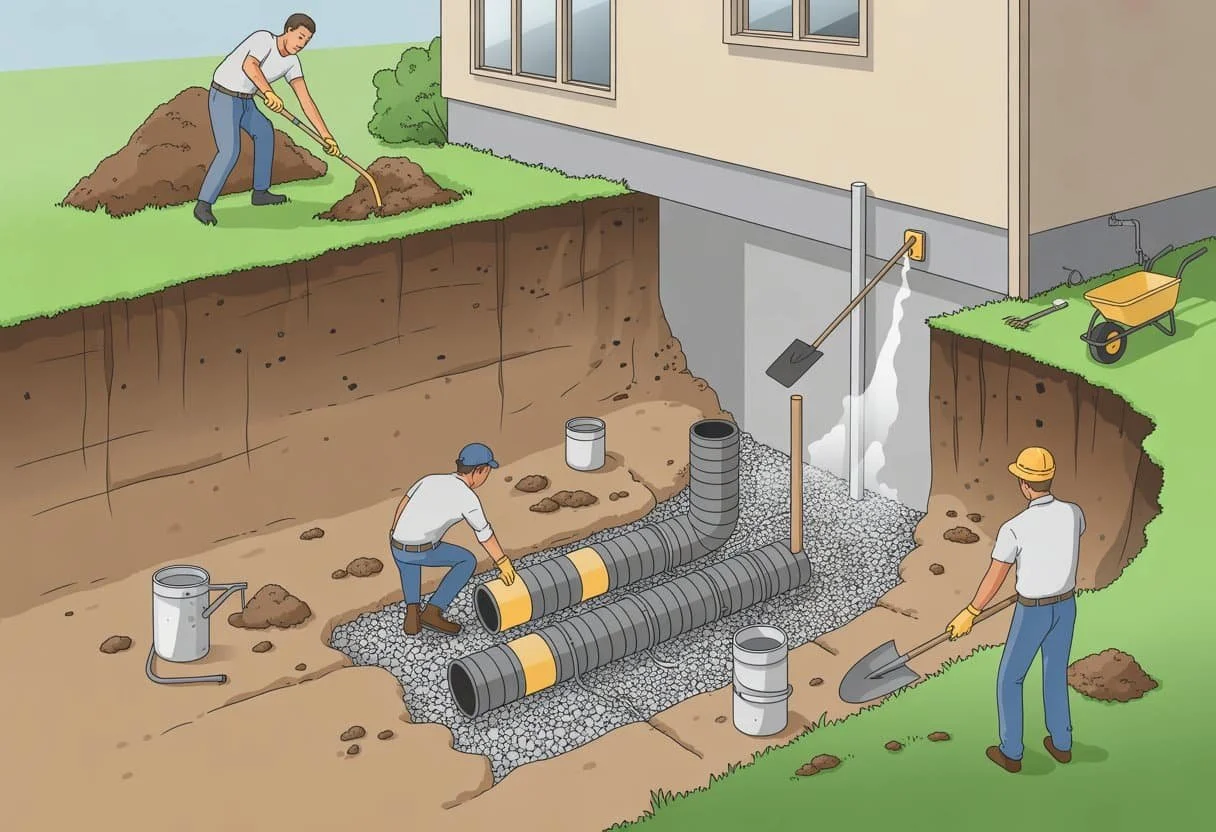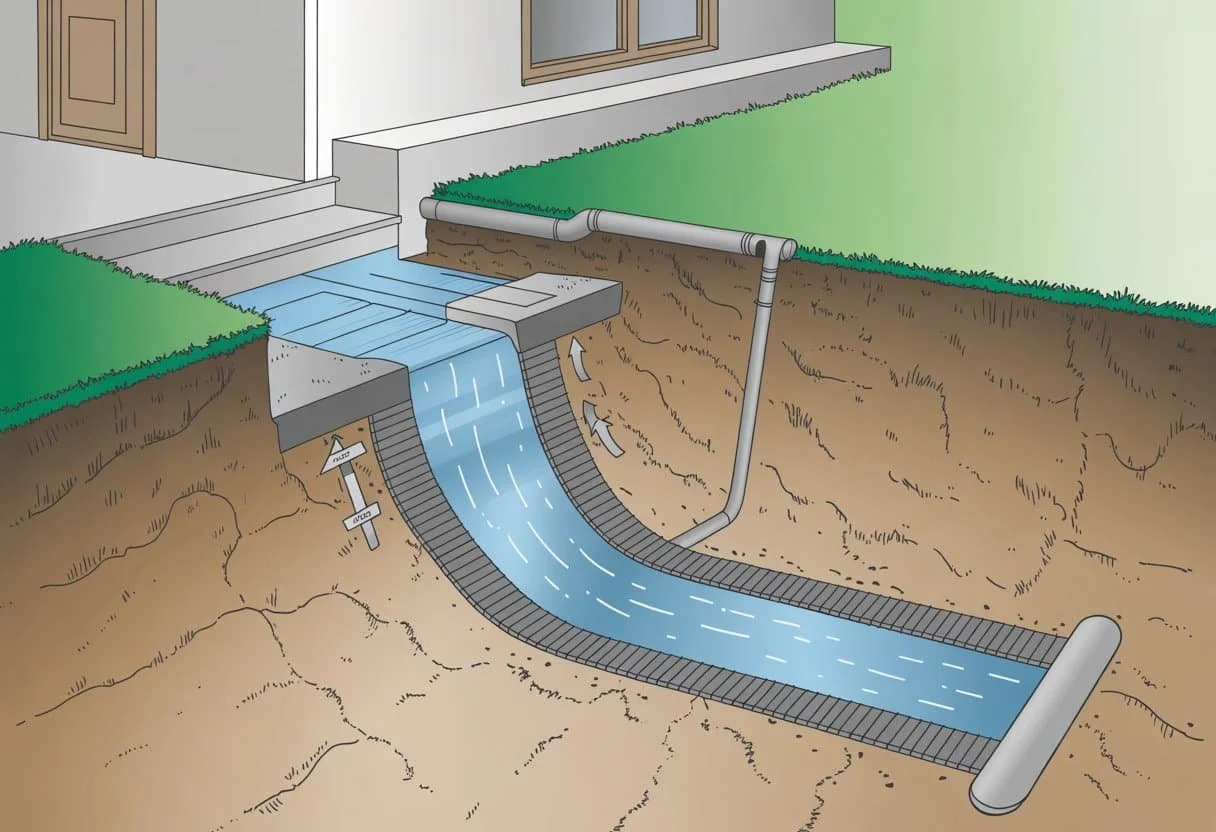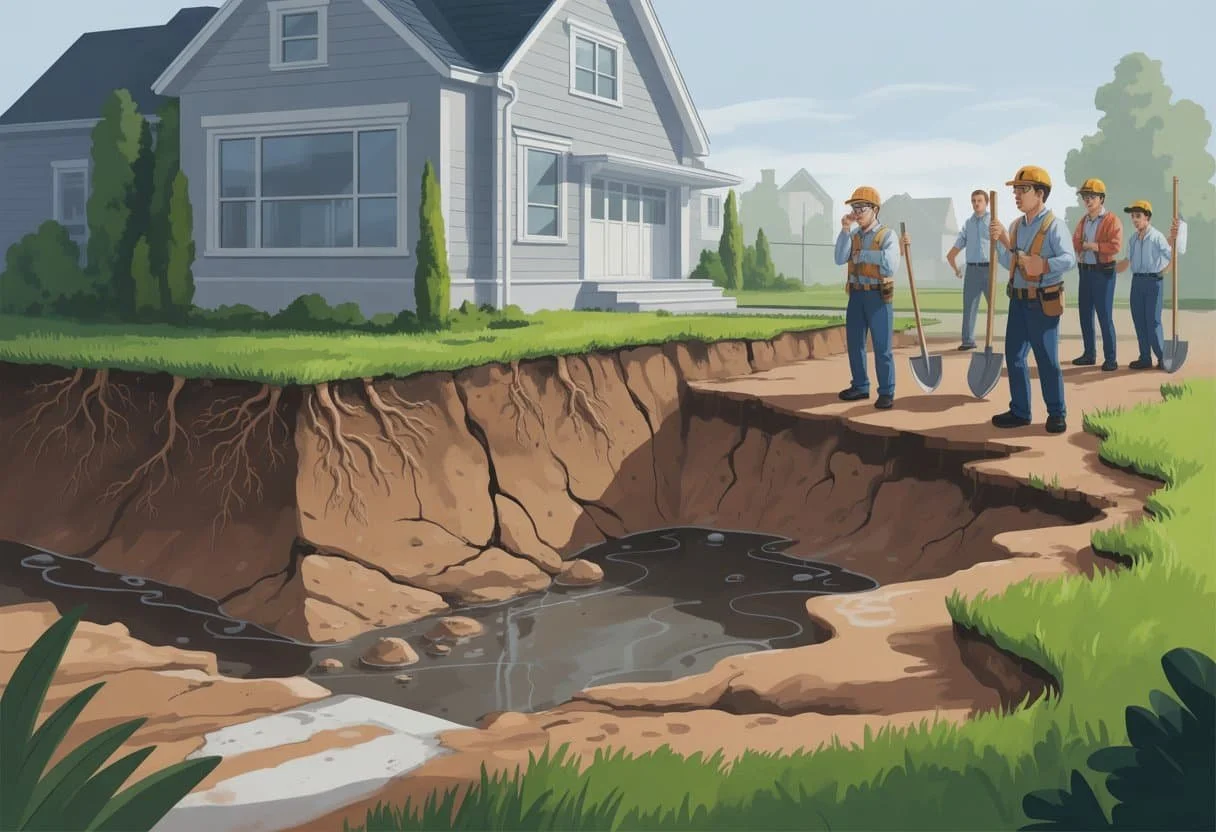Soil Pulling Away From Foundation: Causes, Risks, and Solutions
It’s a funny thing, that little gap between your house and the earth. You see it one day, maybe during a dry spell in August, and you don’t think much of it. But then it seems to get a little wider. A little deeper. And a quiet little worry starts to creep in.
I remember standing in a client’s yard years ago. She was really panicked about the soil pulling away from her front porch. To be fair, it looked dramatic. And it hit me then that we’re not just talking about dirt and concrete. This is about the feeling of security, the idea that your home—your biggest investment, your safe place—is firmly planted. When you see a gap like that, it feels like the house is becoming untethered.
And here’s the thing: sometimes, it is. That separation happens because the soil that’s supposed to be supporting your foundation is shrinking or shifting away. It's no longer doing its job. This opens the door for water to get where it shouldn't, and that’s when a small gap can become the first sign of settling, cracking, and some truly costly structural damage. It’s usually a combination of things—drought, the way clay soil naturally behaves, or even just poor drainage you never knew you had.
Recognizing what you’re seeing early on is everything. It can be the difference between a simple, proactive fix and a massive, foundation-lifting repair project down the road.
Spotting Soil Separation: When To Pay Attention
So how do you tell the difference between a normal seasonal shift and a real red flag? It really comes down to the size of the gap, when it appears, and what other symptoms are showing up around your house.
Visible Soil Gaps And What They Mean
A small gap of 1-2 centimetres that shows up in the dry season and disappears after a good rain is typically just the clay soil breathing. It’s normal. But when those gaps get wider, they’re telling you that a significant amount of soil volume is gone, or that part of your foundation might actually be settling.
Gap measurement guidelines:
- 0-2 cm: Normal seasonal movement
- 2-5 cm: Monitor closely for changes
- 5+ cm: Professional assessment required
Fresh cracks in the foundation wall that appear at the same time as the gaps are a major warning sign. Look for horizontal cracks, step-pattern cracks in your brickwork, or any vertical splits. And if you see water pooling in those gaps, you’ve got another problem. That standing water can freeze and expand in the winter, basically acting like a wedge that forces the gap even wider.
Natural Versus Concerning Soil Separation
Clay soils are always going to move a bit with the seasons. It’s in their nature. They swell when they’re wet and shrink when they dry out, creating those predictable gaps that close up again when the rain returns.
The separation you need to worry about is the kind that doesn't follow the weather. It’s the gap that’s still there in the middle of a rainy spring, or the one that just seems to get a little wider every single year.
Natural separation characteristics:
- Appears during dry spells
- Closes with rainfall
- Consistent depth around foundation
- No structural cracks present
Problematic separation signs:
- Persists through wet seasons
- Increases in size over time
- Varies dramatically around foundation perimeter
- Accompanied by foundation cracks
Even trees can play a role. A big, thirsty maple can cause normal seasonal soil movement. But if you have a large tree removed, the decaying roots can leave behind a permanent void in the soil, which is a different problem entirely.
Common Homeowner Concerns And Misconceptions
Honestly, I see homeowners fall into one of two camps: they either panic at the first sight of any gap, or they ignore a gaping chasm for years.
- Myth: All soil gaps indicate foundation failure. Reality: Seasonal movement is normal for most soil types.
- Myth: Filling gaps with soil prevents problems. Reality: Improper backfill can worsen drainage issues.
The biggest misconception is about timing. People will watch a gap grow for years, ignoring the sticking doors and drywall cracks that come with it. By the time they call for help, what could have been a manageable issue has become a major, complex repair. Some people also think their sprinkler system is helping, but excessive watering can actually destabilize the soil and cause a whole different set of foundation problems. A professional assessment is really needed when those gaps get over 5 centimetres, stick around all year, or you start seeing those structural cracks.
Image Suggestion: Photo Of Soil Gap Around Foundation
A clear photograph showing a measured soil gap against a concrete foundation wall, with a ruler indicating the gap width and visible soil layers demonstrating the separation depth.
What Drives Soil Movement Around Foundations
The ground beneath your house is constantly reacting to changes in moisture, weather, and even your landscaping choices. The main culprit, especially in many parts of the country, is expansive clay soil, which acts like a sponge. foundation challenges.
Moisture Changes And Expansive Soils
Clay soils have these minerals that just love to absorb water. When they get wet, they can swell up by as much as 10%. Then, when they dry out, they shrink and crack. It's this cycle of swelling and shrinking that creates those gaps between the soil and your foundation walls.
Expansive soil types include:
- Bentonite clay
- Montmorillonite clay
- Smectite clay
Key moisture sources:
- Heavy rainfall
- Broken water pipes
- Poor drainage systems
- Irrigation systems
Sandy soils, on the other hand, drain quickly and don’t really expand, so they cause far fewer issues. The "plasticity index" is a term engineers use to measure how much a soil might expand. Anything over 20 is considered highly expansive.
Impact Of Weather And Seasonal Conditions
You can practically set your calendar to the soil cycle. Spring brings rain and snowmelt, saturating the soil and causing it to expand. Then the summer heat arrives, baking the moisture out and causing the soil to contract and pull away from the foundation.
Seasonal moisture patterns:
- Spring: Soil expansion from snowmelt and rain
- Summer: Soil contraction from heat and drought
- Fall: Moderate moisture levels
- Winter: Frozen ground prevents movement
It’s the extreme weather that does the most damage. A drought that lasts for months can cause severe shrinkage, creating huge gaps. Temperature matters too. The freeze-thaw cycle in winter can cause the moisture in the ground to expand and contract, a process called frost heave, which can put immense pressure on your foundation.
Influences From Landscaping, Trees, And Drainage
That beautiful old oak tree in your yard? It can drink 150-300 litres of water from the soil every single day through its roots. When a tree that big is planted too close to a house, it can create a localized drought, causing one corner of your foundation to settle.
Trees that cause the most soil movement:
- Willow trees
- Poplar trees
- Oak trees
- Maple trees
As a rule of thumb, you should plant large trees at least 6 metres away from your foundation. And your drainage system is critical. Clogged gutters and downspouts that dump water right next to the house are basically injecting huge amounts of moisture exactly where you don’t want it, forcing the soil to expand aggressively.
Risks Associated With Soil Pulling Away
When that soil separates from your foundation, it’s not just an eyesore. It's a genuine threat to the stability of your home and its value. The longer it's left alone, the more the risks and the repair costs multiply.
Effects On Foundation Stability
Think of the soil around your foundation as a brace. It provides lateral support, pushing back against the foundation and holding it in place. When that soil pulls away, that support is gone. The foundation walls can start to shift, bow inward, or lean outward under the immense weight of the house.
Immediate stability concerns include:
- Reduced lateral soil pressure against walls
- Increased risk of foundation movement
- Compromised structural load distribution
- Weakened resistance to frost and water damage
This is especially true with clay soils. The footing of your foundation, which is designed to distribute the building’s load across the soil, can’t do its job properly if the soil beneath and beside it has disappeared.
Common Signs Of Foundation Stress
The stress on your foundation doesn't stay in the basement. It travels up through the entire structure of your home, and the signs are often subtle at first.
Visible exterior indicators:
- Cracks in foundation walls
- Gaps between soil and foundation
- Tilting or leaning walls
- Separation around basement windows
Inside, you might notice doors that suddenly stick or won't latch anymore. Windows might become difficult to open or close. You might see cracks appear in the drywall, especially coming off the corners of door and window frames.
Interior warning signs include:
- Doors that won't close properly
- Cracks in drywall or plaster
- Uneven floors or squeaky boards
- Basement moisture problems
Structural Risks Of Unchecked Soil Gaps
Ignoring these gaps is like ignoring a leaky roof. The problem doesn't go away; it just gets progressively worse. Foundation settlement happens when the support is gone and the sheer weight of the house pushes parts of the foundation down.
Progressive damage includes:
- Foundation wall cracking and bowing
- Structural beam sagging
- Roof line irregularities
- Plumbing and electrical system damage
Water infiltration makes everything worse, accelerating the damage. Gaps let moisture seep in, which freezes in the winter, expands, and widens existing cracks. In the long term, this can lead to catastrophic failures and repair costs that can easily exceed $50,000.
Immediate Actions To Protect Your Foundation
Okay, so you’ve spotted a gap. Don’t panic, but don’t ignore it. Taking some quick, simple actions can help you assess the situation and prevent the problem from escalating while you figure out your next steps.
Regular Monitoring And Documentation
Become a detective. Every couple of weeks during dry weather, go out and inspect the gap. Use a ruler or tape measure to check the width and depth. Take photos from the exact same spot each time, and make sure you date them.
Record your measurements in a simple log. This documentation is incredibly valuable because it will show you—and any professional you might call—whether the problem is stable, seasonal, or actively getting worse.
Key measurements to track:
- Gap width at widest point
- Gap depth from surface
- Length of affected area
- Soil moisture level (dry, moist, or wet)
Quick Fixes To Avoid
What you don’t do is almost as important as what you do. At first I didn’t get it, but some common-sense fixes can actually cause more harm than good.
Common mistakes that cause damage:
- Packing clay soil too tightly
- Using the wrong soil type for backfill
- Creating slopes that drain toward the foundation
- Installing sprinklers that oversaturate the area
Never just dump a wheelbarrow of dirt against the foundation to fill the gap. And avoid the temptation to just soak the area with a garden hose; too much water too quickly can destabilize the soil. Temporary fixes like foam sealants are useless—they don’t address the root cause and can trap moisture.
Maintaining Consistent Soil Moisture
The goal is to keep the soil moisture level stable. A soaker hose is a great tool for this. Lay it a couple of feet from your foundation and let it run on low for a few hours. You want to apply water slowly so it can penetrate deeply. The soil should feel like a wrung-out sponge: damp, but not soggy.
Proper watering schedule:
- Summer: Every 2-3 days for 30 minutes
- Spring/Fall: Every 4-5 days for 20 minutes
- Winter: Monitor only, water if soil cracks appear
Adding a couple of inches of mulch around the foundation can also work wonders to help retain moisture. Just remember to keep the mulch about six inches away from the foundation wall itself.
Infographic Of Do's And Don'ts
| DO | DON'T |
|---|---|
| Water soil gradually with soaker hose | Flood area with garden hose |
| Maintain consistent moisture levels | Let soil completely dry out |
| Document changes with photos | Ignore growing gaps |
| Use proper grading materials | Pack clay soil against foundation |
| Install drainage away from foundation | Create slopes toward house |
Emergency signs requiring immediate professional help:
- Gaps wider than 2 inches
- New foundation cracks appearing
- Doors or windows sticking
- Visible foundation movement
Best Practices For Moisture Management
Long-term stability is all about controlling the water around your foundation. By being strategic with your irrigation, watering schedules, and landscaping, you can maintain the steady moisture levels that prevent soil from pulling away.
Irrigation And Drip Line Installation
Drip irrigation systems are the best choice near a foundation. They deliver water directly and slowly to the soil, maintaining consistent moisture without oversaturation. You should install drip lines about 60-90 cm away from the foundation walls.
Position emitters every 30-45 cm along the drip line for even water distribution. Clay soils require lower flow rates (1-2 litres per hour) compared to sandy soils (4-6 litres per hour).
Key installation requirements:
- Pressure-compensating emitters for consistent flow
- Filter systems to prevent clogging
- Timer controls for automated scheduling
- Proper slope (1% minimum) for drainage
Try to avoid traditional sprinkler systems close to the house, as they often spray water against the foundation and create uneven moisture patterns that can lead to problems.
Watering Schedules To Mimic Rainfall
The goal is to prevent those extreme wet-dry cycles that cause soil to expand and contract so dramatically. It’s better to water deeply but less frequently, which encourages stable soil conditions.
Seasonal watering guidelines:
- Spring: 2-3 times per week for 30-45 minutes
- Summer: Daily watering during hot periods
- Fall: Reduce to 1-2 times per week
- Winter: Minimal watering except during dry spells
A simple soil moisture meter can be a great tool to check conditions about 15-20 cm deep. And always adjust your schedule based on actual rainfall.
Benefits Of Mulching And Landscaping
Organic mulch is like a protective blanket for your soil. A 5-8 cm layer of shredded bark or wood chips will slow down evaporation during dry spells. Just be sure to keep it 15 cm away from the foundation wall itself.
Effective mulch materials:
- Shredded bark (lasts 2-3 years)
- Wood chips (breaks down slowly)
- Compost (adds nutrients)
- Leaf mould (improves soil structure)
The plants you choose also matter. Opt for native plants with similar water needs to reduce how much you have to irrigate. And most importantly, ensure the soil around your foundation has a 5% slope away from the house to keep water from ever pooling there.
Signs It's Time To Call In Experts
There comes a point where monitoring and watering aren't enough. Certain warning signs are your foundation’s way of telling you that it needs professional help from someone with specialized expertise.
Checklist Of Warning Signals
Visible Foundation Gaps
- Soil separation of 2.5 cm or more around the foundation perimeter
- Cracks wider than 3 mm in basement walls
- Horizontal cracks along foundation joints
Interior Warning Signs
- Doors and windows that stick or won't close properly
- New cracks in drywall, especially around door frames
- Floors that feel uneven or have developed slopes
- Basement moisture or water infiltration
Exterior Foundation Problems
- Concrete steps pulling away from the house
- Gaps between foundation and attached structures like porches
- Visible foundation settling or tilting
Drainage Issues
- Water pooling near the foundation after rain
- Gutters overflowing or directing water toward the house
- Landscaping that slopes toward the foundation
Value Of Structural And Geotechnical Assessments
When you call in a specialist, they’re doing two key things. A structural assessment looks at the foundation itself—its condition, the cracks, the stress it's under. A geotechnical assessment looks at the soil—its composition, moisture levels, and potential to expand. You need both to understand the full picture of what’s really going on.
What These Assessments Include:
- Soil boring tests to determine soil type and stability
- Foundation load calculations and stress analysis
- Moisture content measurements in surrounding soil
- Recommendations for drainage improvements
An assessment might cost $500-$2,000, but it can prevent a $50,000 repair job by catching the problem early.
Routine Foundation Inspections
Getting into the habit of inspecting your foundation every spring and fall is one of the smartest things a homeowner can do. After the winter freeze-thaw cycle is a critical time to check for new cracks or movement.
Spring Inspection Focus:
- Check for new cracks or expanded existing ones
- Examine drainage around the foundation perimeter
- Look for signs of soil movement or settling
Fall Preparation:
- Ensure proper grading slopes away from foundation
- Clear gutters and downspouts
- Seal minor cracks before winter
Even with your own checks, having a professional inspection every 3-5 years provides a deeper analysis and can spot issues you would never see.
Callout Box: When To Seek Help Guide
| Immediate Action Required | Schedule Professional Assessment | Monitor Closely |
|---|---|---|
| Foundation cracks wider than 6 mm | Soil gaps 2.5–5 cm wide | Hairline cracks in basement |
| Doors/windows won't close | Basement moisture issues | Minor settling around steps |
| Visible foundation tilting | Recurring drainage problems | Seasonal soil movement |
| Water entering basement | Multiple small cracks appearing | Gutters need frequent cleaning |
If you notice rapid crack growth or visible foundation movement, you should contact a foundation specialist immediately.
Professional Solutions For Persistent Soil And Foundation Problems
When the soil movement is severe and has already caused damage, you need to go beyond moisture management. This is where engineers intervene with structural reinforcement and advanced drainage to provide a permanent fix.
Foundation Reinforcement Options
When the soil movement is severe and has already caused damage, you need to go beyond moisture management. This is where engineers intervene with structural reinforcement and advanced drainage to provide a permanent fix.
- Push piers are steel piers that are hydraulically driven through the unstable soil until they hit bedrock or a solid load-bearing layer.
- Helical piers are like giant steel screws that are twisted into the ground, which works well in expansive clay soils.
- Concrete piersare another permanent support option.
- Slab jacking is a technique used to lift sunken concrete slabs by pumping a material underneath, but it's not typically for the main house foundation.
These repairs are a significant investment, often ranging from $10,000 to $40,000, but they solve the problem at its core.
Drainage Improvements And Water Management
- French drains are underground systems that use a perforated pipe and gravel to intercept groundwater and channel it safely away from your foundation.
- Surface drainage involves regrading your yard to ensure water flows away from the house.
- Waterproofing membranes can be applied to foundation walls to act as a barrier against moisture penetration.
- Sump pumps are essential in areas with high water tables to actively pump water out of your basement or crawl space.
Vegetation Management For Soil Stability
- Root barriers can be installed underground to prevent tree roots from growing toward your foundation and sucking the moisture out of the soil.
- Proper plant selection means avoiding large, thirsty trees within 20 feet of your house.
- Soil amendments like adding sand or organic matter to heavy clay can improve its drainage and reduce the expansion/contraction cycle.
Foundation Repair And Drainage Solutions
| Problem | Solution | Cost Range | Timeline |
|---|---|---|---|
| Foundation settling | Push piers | $15,000–$30,000 | 3–5 days |
| Water pooling | French drain | $3,000–$8,000 | 1–2 days |
| Soil expansion | Root barriers | $500–$2,000 | 1 day |
| Poor drainage | Regrading | $1,000–$5,000 | 2–3 days |
Long-Term Strategies To Maintain Foundation Stability
True foundation stability isn’t a one-and-done fix. It’s about building good habits into your yearly home maintenance routine to manage moisture and keep an eye on your drainage systems.
Year-Round Moisture Management
The goal is always consistency. You want to prevent those wild swings in soil moisture. During dry spells, make it a habit to water the soil within about 1.5 metres of your foundation. Use a soaker hose to apply the water slowly so it can penetrate deeply without creating a muddy mess. A simple soil moisture probe can tell you if you’re getting it right—you want it to be slightly damp, not wet and not dusty dry, all year round.
Inspection And Maintenance Of Drainage And Landscaping
Twice a year, in the spring and fall, make it a point to inspect your drainage. Clean out your gutters and downspouts. Walk around your house after a heavy rain and look for any areas where water is pooling. That’s a sign your grading needs to be fixed. Trim back any shrubs or plants that are growing right up against the foundation, as their roots can trap moisture and disrupt drainage.
Encouraging Proactive Homeowner Habits
Make a monthly walk-around part of your routine. Just five minutes to look for any new cracks or changes in the gaps around the foundation. Take photos from the same spots every season to create a visual log.
This makes it so much easier to spot slow, gradual changes. Addressing a tiny issue as soon as you see it is always cheaper and easier than waiting for it to become a huge problem.
Seasonal Infographic: Soil Moisture And Care
- Spring (March-May): Inspect winter damage to drainage systems. Begin regular watering schedule. Apply fresh mulch around foundation.
- Summer (June-August):Increase watering frequency during hot periods. Monitor for drought stress signs. Maintain consistent moisture levels.
- Autumn (September-November: Clear gutters and downspouts. Reduce watering as temperatures drop. Prepare drainage systems for winter.
- Winter (December-February: Ensure proper snow drainage away from foundation. Check for ice dam formation. Monitor for freeze-thaw soil movement.
Summary And Next Steps
I've walked through so many homes where a huge, expensive problem started as something small. A little crack. A sticky door. And almost every single time, the owner says the same thing: "I saw it starting, but I just hoped it would go away."Here’s the thing—it doesn’t go away. The soil keeps moving, the seasons keep changing, and the pressure on your foundation is relentless. That gap you’re seeing isn't just an aesthetic issue; it's a symptom. It's the earth telling you that something is out of balance. Paying attention to that message is one of the most important things you can do as a homeowner. It’s not glamorous, but it’s the work that keeps your home standing strong, the work that protects your family and your investment. It’s easy to look away, but that soil is going to be there long after we are. It’s worth the effort to understand it.
Call To Action: Schedule Inspection Or Download Checklist
Contact Exactus Engineering today to schedule a foundation inspection if you notice soil separation around your home. Our certified engineers provide comprehensive assessments within 48 hours of scheduling.
Schedule online through our website or call our office directly. We serve residential and commercial properties with same-day emergency consultations available.
Download our foundation inspection checklist to conduct preliminary assessments before our visit. This free resource helps identify potential problems and documents conditions for our engineers. Our reports give you clear language, detailed photos, and prioritized recommendations so you know exactly what you’re dealing with.
Frequently Asked Questions
What are the consequences of gaps forming between the soil and a home's foundation?
The two biggest consequences are water intrusion and loss of support. That gap acts like a funnel for water, directing it right to your foundation wall, which can lead to leaks and frost damage. It also means your foundation has lost its brace on that side, leaving it vulnerable to shifting and settling under the house's weight.
How can I fill the space where soil has eroded from around my foundation?
You need to be careful with this. For minor, seasonal gaps, you can use a dense, clay-based fill, but it's critical that you compact it in thin layers and make sure it's graded to slope away from the house. If the gap is more than an inch or so wide, just filling it is like putting a bandage on a broken arm—it covers the problem but doesn't fix the cause.
What role does clay soil play in foundation stability, and how can it be improved?
Clay soil is the main character in most foundation stories because of its ability to expand dramatically when wet and shrink when dry. This constant movement puts enormous stress on foundations. You can't change the soil, but you can manage its moisture. That means improving drainage to get excess water away and providing consistent, light watering during droughts to prevent severe shrinkage.
Is it advisable to add more dirt around the foundation of my house?
Sometimes, yes, if the ground has settled and you need to rebuild the slope away from your house. But you must do it correctly. Never pile dirt up against your home's siding (it can cause rot and attract pests), and always ensure you're creating a positive grade for drainage. Done wrong, it can trap water and make the problem worse.
What is the best type of fill dirt to use for supporting house foundations?
You want to use a structural fill, which is typically a clay-based soil that can be properly compacted to provide good support. You should avoid using organic topsoil, as it will decompose and settle over time, and sandy soil, which doesn't compact well and provides poor support.
What are the signs that my foundation might need repair due to soil movement?
Inside your house, look for doors and windows that stick, cracks in the drywall (especially over doorways), and floors that feel sloped or uneven. Outside, look for cracks in the foundation itself (horizontal or stair-step cracks are major red flags) and things like porches or chimneys pulling away from the house. These are signs the problem has moved from the soil to the structure itself.

